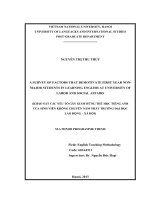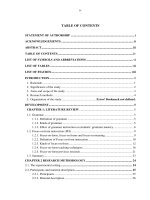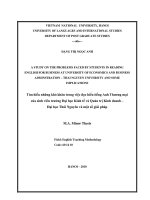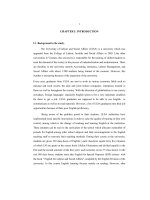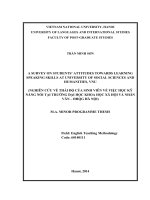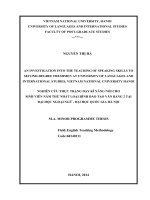chap71 pps Automotive technology at University of Cambridge
Bạn đang xem bản rút gọn của tài liệu. Xem và tải ngay bản đầy đủ của tài liệu tại đây (1.48 MB, 61 trang )
start
Automotive Technology: Principles, Diagnosis, and Service, 3rd Edition
By James D. Halderman
©©2008
2009Pearson
PearsonEducation,
Education,Inc.
Inc.
Pearson
PearsonPrentice
PrenticeHall
Hall- -Upper
UpperSaddle
SaddleRiver,
River,NJ
NJ07458
07458
OBJECTIVES:
After studying Chapter 71, the reader should
be able to:
•
•
•
•
•
Prepare for ASE Brakes (A5) certification test.
List the types of brake fluids.
Describe where armored brake line is used.
Discuss the differences between double-flare
and ISO flare.
Explain how flexible brake lines should be
handled during service.
Continued
Automotive Technology: Principles, Diagnosis, and Service, 3rd Edition
By James D. Halderman
©©2008
2009Pearson
PearsonEducation,
Education,Inc.
Inc.
Pearson
PearsonPrentice
PrenticeHall
Hall- -Upper
UpperSaddle
SaddleRiver,
River,NJ
NJ07458
07458
OBJECTIVES:
After studying Chapter 71, the reader should
be able to:
•
•
•
List the precautions necessary when handling
or disposing of brake fluid.
Discuss the types of rubber that are used in
brake system components.
Automotive Technology: Principles, Diagnosis, and Service, 3rd Edition
By James D. Halderman
©©2008
2009Pearson
PearsonEducation,
Education,Inc.
Inc.
Pearson
PearsonPrentice
PrenticeHall
Hall- -Upper
UpperSaddle
SaddleRiver,
River,NJ
NJ07458
07458
KEY TERMS:
armored brake line
brake fluid • brake lines • brake pipes • brake tubing
DOT 3 • DOT 4 • DOT 5 • DOT 5.1 • double flare
elastomers • flexible brake hoses
hydraulic system mineral oil (HSMO) • hygroscopic
International Standards Organization (ISO)
nonhygroscopic • polyglycol • silicone brake fluid
Automotive Technology: Principles, Diagnosis, and Service, 3rd Edition
By James D. Halderman
©©2008
2009Pearson
PearsonEducation,
Education,Inc.
Inc.
Pearson
PearsonPrentice
PrenticeHall
Hall- -Upper
UpperSaddle
SaddleRiver,
River,NJ
NJ07458
07458
BRAKE FLUID
Brake fluid is designed to function in the hydraulic brake system
under all operating conditions. Brake fluid boiling point is one of
the most critical aspects and ratings for brake fluid.
As brake fluid ages, it absorbs moisture, which lowers its boiling
point and causes increased corrosion of the brake system
components.
Automotive experts agree that brake fluid should be changed
regularly as part of normal routine service. Getting the old lowboiling-point brake fluid out of the system could prevent a total
loss of brakes due to brake fluid boiling!
Continued
Automotive Technology: Principles, Diagnosis, and Service, 3rd Edition
By James D. Halderman
©©2008
2009Pearson
PearsonEducation,
Education,Inc.
Inc.
Pearson
PearsonPrentice
PrenticeHall
Hall- -Upper
UpperSaddle
SaddleRiver,
River,NJ
NJ07458
07458
All brake fluids must be able to pass tests for the following:
1. Fluidity at low temperatures
2. Controlled percentage loss to evaporation
at high temperatures (212°F [100°C])
3. Compatibility with other brake fluids
4. Resistance to oxidation
5. Specific effects on rubber, including:
a. No disintegration
b. No increase in hardness of rubber tested
c. Limited amount of decrease in hardness
of the rubber
Figure 71–1 Brake fluid can absorb moisture from the air even through plastic, so many experts
recommend that brake fluid be purchased in metal containers.
Automotive Technology: Principles, Diagnosis, and Service, 3rd Edition
By James D. Halderman
©©2008
2009Pearson
PearsonEducation,
Education,Inc.
Inc.
Pearson
PearsonPrentice
PrenticeHall
Hall- -Upper
UpperSaddle
SaddleRiver,
River,NJ
NJ07458
07458
BRAKE FLUID TYPES
Brake fluid is made from a combination of various types of glycol,
a non-petroleum-based fluid. Brake fluid is a polyalkylene–
glycol–ether mixture called polyglycol for short.
All polyglycol brake fluid is clear to amber in color.
Brake fluid has to have the following characteristics
A high boiling point
A low freezing point
No ability to damage rubber parts in the brake system
Continued
Automotive Technology: Principles, Diagnosis, and Service, 3rd Edition
By James D. Halderman
©©2008
2009Pearson
PearsonEducation,
Education,Inc.
Inc.
Pearson
PearsonPrentice
PrenticeHall
Hall- -Upper
UpperSaddle
SaddleRiver,
River,NJ
NJ07458
07458
BRAKE FLUID SPECIFICATIONS
All automotive brake fluid must meet federal Motor Vehicle Safety
Standard 116. The SAE and the Department of Transportation
(DOT) have established brake fluid specification standards as
shown in the following chart:
See the chart on Page 849 of your textbook.
Automotive Technology: Principles, Diagnosis, and Service, 3rd Edition
By James D. Halderman
Continued
©©2008
2009Pearson
PearsonEducation,
Education,Inc.
Inc.
Pearson
PearsonPrentice
PrenticeHall
Hall- -Upper
UpperSaddle
SaddleRiver,
River,NJ
NJ07458
07458
DOT 3 The type most often used is DOT 3. Important
characteristics:
1. DOT 3 can absorb 2% of its volume in water per year through
microscopic seams in the brake system and around seals. Over
time, the water will corrode the system and thicken the brake
fluid. The moisture can also cause a spongy brake pedal, due
to reduced vapor-lock temperature.
2. DOT 3 must be used from a sealed (capped) container. If
allowed to remain open for any length of time, DOT 3 will
absorb moisture from the surrounding air, which is called
hygroscopic.
3. Always check brake fluid recommendations on the top of the
master cylinders of imported vehicles before adding DOT 3.
See Figure 71–2.
Continued
Automotive Technology: Principles, Diagnosis, and Service, 3rd Edition
By James D. Halderman
©©2008
2009Pearson
PearsonEducation,
Education,Inc.
Inc.
Pearson
PearsonPrentice
PrenticeHall
Hall- -Upper
UpperSaddle
SaddleRiver,
River,NJ
NJ07458
07458
Figure 71–2 Brake fluid absorbs moisture from the air at the rate of about 2% per year. As the
brake fluid absorbs water, its boiling temperature decreases.
CAUTION: DOT 3 brake fluid is a very strong solvent and can remove
paint! Care is required when working with DOT 3 brake fluid to avoid
contact with the vehicle’s painted surfaces. It also takes the color out of
leather shoes.
Continued
Automotive Technology: Principles, Diagnosis, and Service, 3rd Edition
By James D. Halderman
©©2008
2009Pearson
PearsonEducation,
Education,Inc.
Inc.
Pearson
PearsonPrentice
PrenticeHall
Hall- -Upper
UpperSaddle
SaddleRiver,
River,NJ
NJ07458
07458
NOTE: Because brake fluid absorbs moisture over time, many vehicle
manufacturers recommend changing the brake fluid as part of the standard
services to be performed routinely. The typical recommended brake fluid
change interval is every two years or every 30,000 miles (48,000 km),
whichever comes first. This is particularly important for vehicles equipped
with an antilock braking system (ABS) because of the problem of
expensive brake component wear or corrosion caused by contaminated
brake fluid.
Automotive Technology: Principles, Diagnosis, and Service, 3rd Edition
By James D. Halderman
©©2008
2009Pearson
PearsonEducation,
Education,Inc.
Inc.
Pearson
PearsonPrentice
PrenticeHall
Hall- -Upper
UpperSaddle
SaddleRiver,
River,NJ
NJ07458
07458
DOT 4 Formulated for use by all vehicles, imported or domestic.
Brake fluid type DOT 4 is polyglycol based but has borate esters
to provide an extra buffer against acids that can form in the
moisture that has been absorbed in the fluid when it is heated.
DOT 4 is approximately double the cost of DOT 3 and can often be
used where DOT 3 is used.
Though the two types of brake fluid are compatible and miscible
(able to be mixed), some vehicle manufacturers recommend that
DOT 3 and DOT 4 not be mixed.
If DOT 4 is to be used, the system should be purged of all of the
old DOT 3 and replaced with DOT 4.
Continued
Automotive Technology: Principles, Diagnosis, and Service, 3rd Edition
By James D. Halderman
©©2008
2009Pearson
PearsonEducation,
Education,Inc.
Inc.
Pearson
PearsonPrentice
PrenticeHall
Hall- -Upper
UpperSaddle
SaddleRiver,
River,NJ
NJ07458
07458
What is Blue Brake Fluid?
Some brake fluid vendors market a high-performance DOT 4 brake fluid that is dyed blue
and is called “super blue” while others market a super DOT 4 that is yellow. These brake
fluids are designed to be sold in Europe.
The advertising states that the bright color of the brake fluid makes it easy to see when
all of the old fluid has been purged from the system during a brake fluid replacement
procedure.
Automotive Technology: Principles, Diagnosis, and Service, 3rd Edition
By James D. Halderman
©©2008
2009Pearson
PearsonEducation,
Education,Inc.
Inc.
Pearson
PearsonPrentice
PrenticeHall
Hall- -Upper
UpperSaddle
SaddleRiver,
River,NJ
NJ07458
07458
DOT 5.1 Non-silicone-based DOT 5.1 is polyglycol fluid and is
clear to amber in color. This severe duty fluid has a boiling point
of over 500°F equal to the boiling point of silicone-based DOT 5
fluid.
Unlike DOT 5, DOT 5.1 can be mixed with either DOT 3 or DOT
4 according to brake fluid manufacturer’s recommendations.
CAUTION: Some vehicle manufacturers such as Chrysler do not
recommend the use of or the mixing of other types of polyglycol brake
fluid and specify the use of DOT 3 brake fluid only. Always follow the
vehicle manufacturer’s recommendation.
Continued
Automotive Technology: Principles, Diagnosis, and Service, 3rd Edition
By James D. Halderman
©©2008
2009Pearson
PearsonEducation,
Education,Inc.
Inc.
Pearson
PearsonPrentice
PrenticeHall
Hall- -Upper
UpperSaddle
SaddleRiver,
River,NJ
NJ07458
07458
DOT 5 Commonly called silicone brake fluid, DOT 5 is made
from polydimethylsiloxanes. It does not absorb any water, and is
therefore called nonhygroscopic.
DOT 5 brake fluid is purple (violet) in color to
distinguish it from DOT 3 or DOT 4 brake fluid.
Silicones have about three times the amount of dissolved air as
glycol fluids (about 15% of dissolved air versus only about 5%
for standard glycol brake fluid).
It is this characteristic of silicone brake fluid that causes the most
concern about its use.
1. Silicone brake fluid has an affinity for air; therefore, it is more
difficult to bleed the hydraulic system of trapped air.
Continued
Automotive Technology: Principles, Diagnosis, and Service, 3rd Edition
By James D. Halderman
©©2008
2009Pearson
PearsonEducation,
Education,Inc.
Inc.
Pearson
PearsonPrentice
PrenticeHall
Hall- -Upper
UpperSaddle
SaddleRiver,
River,NJ
NJ07458
07458
2. The trapped air expands with increasing temperature. This
causes the brake pedal to feel “mushy” because the pressure
exerted on the hydraulic system simply compresses the air in
the system and does not transfer the force to the wheel
cylinders and calipers as it should.
DOT 5 brake fluid has been known to create a braking problem
during high-altitude (over 5,000 ft [1,500 m]) and hightemperature driving. The high altitude tends to vaporize (offgassing) some parts of the liquid, creating bubbles in the brake
system, similar to having air in the brake system.
Continued
Automotive Technology: Principles, Diagnosis, and Service, 3rd Edition
By James D. Halderman
©©2008
2009Pearson
PearsonEducation,
Education,Inc.
Inc.
Pearson
PearsonPrentice
PrenticeHall
Hall- -Upper
UpperSaddle
SaddleRiver,
River,NJ
NJ07458
07458
3. DOT 5 brake fluid should not be mixed with any other type of
brake fluid. Therefore, the entire braking system must be
completely flushed and refilled with DOT 5.
NOTE: The characteristics of DOT 5 silicone brake fluid to absorb air
is one of the major reasons why it is not recommended for use with
an antilock braking system (ABS). In an ABS, valves and pumps are
used which can aerate the brake fluid. Brake fluid filled with air bubbles
cannot properly lubricate the ABS components and will cause a low, soft
brake pedal.
Continued
Automotive Technology: Principles, Diagnosis, and Service, 3rd Edition
By James D. Halderman
©©2008
2009Pearson
PearsonEducation,
Education,Inc.
Inc.
Pearson
PearsonPrentice
PrenticeHall
Hall- -Upper
UpperSaddle
SaddleRiver,
River,NJ
NJ07458
07458
4.
DOT 5 brake fluid should not be mixed with any other type
of brake fluid. Therefore, the entire braking system must be
completely flushed and refilled with DOT 5.
5.
DOT 5 does not affect rubber parts; will not cause corrosion.
6.
DOT 5 is expensive. It is approximately four times the cost
of DOT 3 brake fluid.
NOTE: Even though DOT 5 does not normally absorb water, it is still
tested using standardized SAE procedures in a humidity chamber. After a
fixed amount of time, the brake fluid is measured for boiling point. Since it
has had a chance to absorb moisture, the boiling point after this sequence is
called the minimum wet boiling point.
Automotive Technology: Principles, Diagnosis, and Service, 3rd Edition
By James D. Halderman
©©2008
2009Pearson
PearsonEducation,
Education,Inc.
Inc.
Pearson
PearsonPrentice
PrenticeHall
Hall- -Upper
UpperSaddle
SaddleRiver,
River,NJ
NJ07458
07458
HYDRAULIC SYSTEM MINERAL OIL
Some French-built Citroen and British-designed Rolls-Royce
vehicles use hydraulic system mineral oil (HSMO) as part of
their hydraulic control systems.
The systems in these vehicles use a hydraulic pump to pressurize
hydraulic oil for use in the suspension leveling and braking
systems.
Continued
Automotive Technology: Principles, Diagnosis, and Service, 3rd Edition
By James D. Halderman
©©2008
2009Pearson
PearsonEducation,
Education,Inc.
Inc.
Pearson
PearsonPrentice
PrenticeHall
Hall- -Upper
UpperSaddle
SaddleRiver,
River,NJ
NJ07458
07458
The Sinking Brake Pedal
This author has experienced what happens when brake fluid is not changed
regularly. Just as many techs will tell you, we do not always do what we
know should be done to our own vehicles.
While driving a four-year-old vehicle on vacation in very hot weather in
mountainous country, the brake pedal sank to the floor. When the vehicle
was cold, the brakes were fine. But after several brake applications, the
pedal became soft and spongy and sank slowly to the floor if pressure was
maintained on the brake pedal.
Because the brakes were OK when cold, I knew it had to be boiling brake
fluid. Old brake fluid (four years old) often has a boiling point under 300°F
(150°C). With the air temperature near 100°F (38°C), it does not take much
more heat to start boiling the brake fluid.
After bleeding over a quart (1 liter) of new brake fluid through the system,
the brakes worked normally. I’ll never again forget to replace the brake fluid
as recommended by the vehicle manufacturer. See Figure 71–3 for a tester
that can be used to measure the boiling point of brake fluid.
Automotive Technology: Principles, Diagnosis, and Service, 3rd Edition
By James D. Halderman
©©2008
2009Pearson
PearsonEducation,
Education,Inc.
Inc.
Pearson
PearsonPrentice
PrenticeHall
Hall- -Upper
UpperSaddle
SaddleRiver,
River,NJ
NJ07458
07458
Figure 71–3 A brake fluid tester can test brake fluid for boiling point.
Automotive Technology: Principles, Diagnosis, and Service, 3rd Edition
By James D. Halderman
©©2008
2009Pearson
PearsonEducation,
Education,Inc.
Inc.
Pearson
PearsonPrentice
PrenticeHall
Hall- -Upper
UpperSaddle
SaddleRiver,
River,NJ
NJ07458
07458
CAUTION: Mineral hydraulic oil should never be used in a braking
system that requires DOT 3 or DOT 4 polyglycol-based brake fluid. If any
mineral oil, such as engine oil, transmission oil, or automatic transmission
fluid (ATF), gets into a braking system that requires glycol brake fluid,
every rubber part in the entire braking system must be replaced. Mineral
oil causes the rubber compounds that are used in glycol brake fluid
systems to swell, as shown here.
Figure 71–4 Both rubber sealing cups were exactly the same size. The cup on the left was
exposed to mineral oil. Notice how the seal greatly expanded.
Automotive Technology: Principles, Diagnosis, and Service, 3rd Edition
By James D. Halderman
©©2008
2009Pearson
PearsonEducation,
Education,Inc.
Inc.
Pearson
PearsonPrentice
PrenticeHall
Hall- -Upper
UpperSaddle
SaddleRiver,
River,NJ
NJ07458
07458
BRAKE FLUID INSPECTION AND TESTING
The brake fluid should be inspected regularly, including the following
items:
1. Proper Level The brake fluid level should be above the
minimum level (labeled MIN) and below the maximum
(labeled MAX) on the side of the master cylinder reservoir.
Do not add brake fluid unless the entire brake system is
carefully inspected for worn brake pads and shoes and for
signs of any external leakage.
2. Color/Condition New brake fluid is clear or amber in color,
if the brake fluid is black or discolored it should be changed.
See Figures 71-5 and 71-6.
Continued
Automotive Technology: Principles, Diagnosis, and Service, 3rd Edition
By James D. Halderman
©©2008
2009Pearson
PearsonEducation,
Education,Inc.
Inc.
Pearson
PearsonPrentice
PrenticeHall
Hall- -Upper
UpperSaddle
SaddleRiver,
River,NJ
NJ07458
07458
Figure 71–5 New brake fluid is clear or amber
in color as shown here.
Figure 71–6 This brake fluid is black in color
and should be replaced.
NOTE: Some experts recommend replacing the brake fluid if it looks like
coffee, either black coffee or coffee with cream.
Continued
Automotive Technology: Principles, Diagnosis, and Service, 3rd Edition
By James D. Halderman
©©2008
2009Pearson
PearsonEducation,
Education,Inc.
Inc.
Pearson
PearsonPrentice
PrenticeHall
Hall- -Upper
UpperSaddle
SaddleRiver,
River,NJ
NJ07458
07458
3. Tested Using a Tester or Test Strips Often, brake fluid does
not look as if it is bad but has absorbed moisture enough to
reduce its effectiveness.
Figure 71–7 (a) A brake fluid test strip is being used to test the condition of the brake fluid.
(b) The color of the test strip is then compared with a chart on the package, which indicates the
condition.
Continued
Automotive Technology: Principles, Diagnosis, and Service, 3rd Edition
By James D. Halderman
©©2008
2009Pearson
PearsonEducation,
Education,Inc.
Inc.
Pearson
PearsonPrentice
PrenticeHall
Hall- -Upper
UpperSaddle
SaddleRiver,
River,NJ
NJ07458
07458



